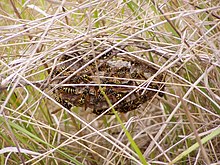Polistes gallicus
| Polistes gallicus | ||||||||||||
|---|---|---|---|---|---|---|---|---|---|---|---|---|

Polistes gallicus |
||||||||||||
| Systematics | ||||||||||||
|
||||||||||||
| Scientific name | ||||||||||||
| Polistes gallicus | ||||||||||||
| ( Linnaeus , 1767) |
Polistes gallicus (synonyms: P. foederata and P. omissa ) is a fold wasp from the family of the fold wasps (Vespidae).
After the former scientific name of the Gallic field wasp , Polistes gallicus , was changed to P. dominula , the species described here was renamed from P. foederata to P. gallicus . Thus the name P. gallicus is no longer used as a synonym for the Gallic field wasp. In the meantime, the species status of P. omissa has also been deleted, this name is now a synonym for the species described here.
features
This field wasp is similar to the Gallic field wasp (Polistes dominula), but its females have yellow cheeks. On the abdomen (abdomen) it has a very variable, yellow-black pattern. On the second abdominal segment (abdominal tergite) two conspicuous yellow spots can be seen, while the following tergites are striped yellow. The cheek of the females is mostly black, occasionally with a small yellow spot.
Occurrence
in warmer regions from France, Switzerland, Austria, northern to Poland, southern Europe to M-Asia, North Africa.
nutrition
They feed predatory on other insects and spiders , but also on flower nectar .
Nest building and reproduction
The nest of the Polistes gallicus is usually founded in spring by a young queen or usually by several people together. Wood putty, which is mixed from wood from dried plant stems and the secretion of the salivary glands , is used as the building substance . The small, sheathless (outwardly open honeycomb) nest is built on a nest handle (as a narrow point, good defense options).
Shortly after the egg-laying, the strongest queen eats the brood of the competitors until they give up the egg-laying and only work as workers. Should the strongest female die, the second strongest follows to her position. The workers feed the larvae and their queen insects (mostly flies ) and spiders, which they chew up and pass on in spherical form.
Diseases and parasites
Polistes gallicus can be attacked by parasitoid fan-winged birds of the species Xenos vesparum .
literature
- Wilhelmine M. Enteman: Coloration in Polistes (= Carnegie Institution of Washington. Publication 19, ISSN 0099-4936 ). Carnegie Institution of Washington, Washington DC 1904.
- Delfa Guiglia: Les Guêpes sociales (Hymenoptera, Vespidae) d'Europe occidentale et septentrionale (= Faune de l'Europe et du Bassin méditerranéen. Vol. 6, ZDB -ID 416815-x ). Masson, Paris 1972.
- Stefano Turillazzi, Mary J. West-Eberhard: Natural history and evolution of paper wasps. Oxford University Press, Oxford u. a. 1996, ISBN 0-19-854947-4 .
- Mary J. West-Eberhard: The social biology of polistine wasps (= University of Michigan. Museum of Zoology. Miscellaneous Publications 140, ISSN 0076-8405 ). Museum of Zoology, Ann Arbor MI1969 (Also: Ann Arbor, Univ. Of Michigan, Diss.).
- Rolf Witt: Observing wasps, identifying them , ISBN 978-3-9813284-0-0 .
